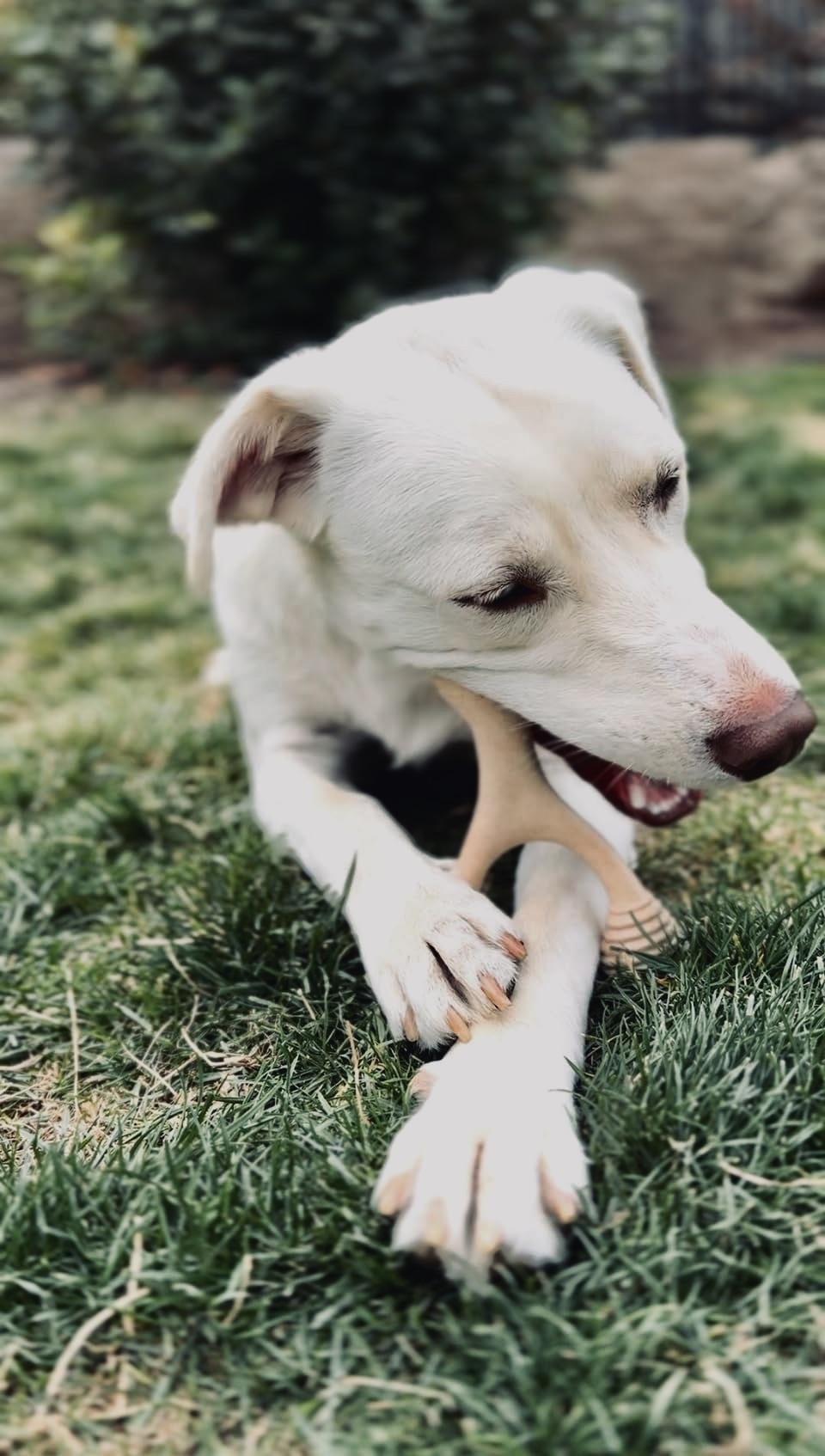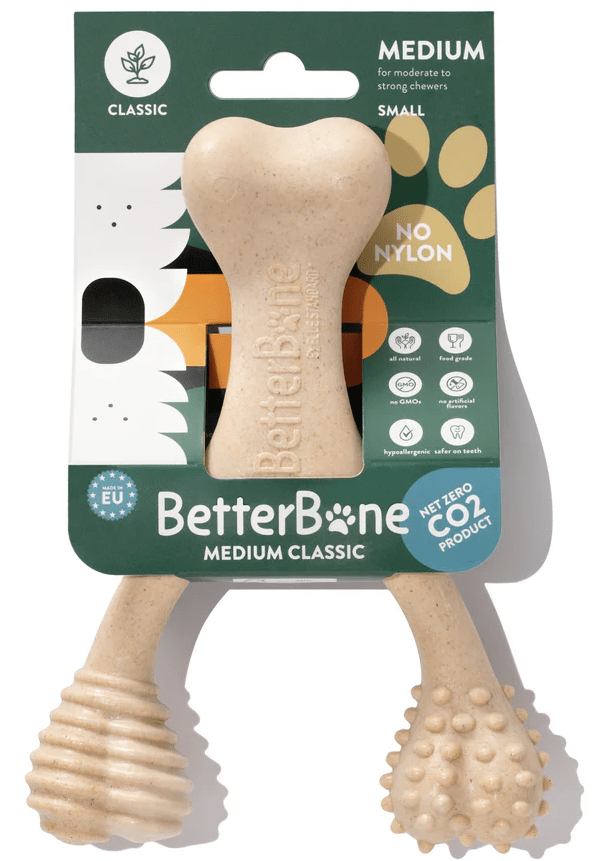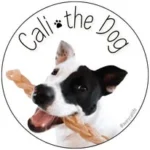There are so many dog chews and bones these days. Today, we’re discussing the pros & cons of the different dog chews we’ve tried, and how some have the potential to be dangerous to your dogs.

Some of the most popular ones are raw bones, antlers, rubber chews, alternative bones, bully sticks, and Yak chews. Which dog chews are best for your pet’s chewing habits, and which are too risky to try at all?
Antlers
Antlers are eco-friendly because they’re naturally shed and collected by hand. They’re interesting, how they differ from one animal to the next. The density of the inside (marrow) and the protective outside are different based on what animal they come from.
The outer core of an antler is the toughest part, so unsplit antlers are, generally, recommended for heavy/aggressive chewers. For example, deer antlers are the hardest, putting your dog at risk of cracking a tooth when chewing on them. Moose antlers are softest, and best for puppies or senior dogs, while elk are in between, and best for average chewers. If you’re considering antlers for your dog, get them split, so your dog can access the soft, healthy marrow.
Marrow density can vary, based on what part of the antler it’s cut from. The top of an antler is less dense than the base. The base of the antler needs to be thicker and stronger to hold up the rest of the antler.
Remember to keep your dog’s chewing habits in mind. Are they gentle chewers? Is your dog a destroyer? All chews come with risks. The softer the antler, the more likely it is to splinter. The harder it is, the higher the risk of tooth damage. Elk antlers are a good choice for many chewers, as it has a nice balance of density and hardness. Also, look for “Grade A or A+” antlers, and always supervise your dog when chewing on anything.
Nylabones & Benebones
Nylabone and Benebone are similar dog bone alternatives, made with nylon, which is a form of plastic. Nylabone has an edible version of their bone, but it contains starches and other fillers. These brands are popular and can be safe for mild to average chewers, but are dense, so they can be risky for aggressive chewers and dogs with weak teeth or gum issues. They may also cause damage if pieces are ingested (excluding the edible Nylabone).
The bottom line is plastic is toxic and not meant to be ingested. I would not recommend the original Nylabone or Benebone, but the edible Nylabone is a potential option, if you don’t mind the added fillers. I prefer cleaner alternatives, but I’ll get to that later.
Rubber Toy Chews
I have two incredibly aggressive chewers! My dogs both LOVE to chew on their WestPaw rubber dog “bones” or their Kongs, and most of the time, these toys hold up to the chewing, but they can be dangerous in another way.
Rubber is rubber. It’s tough, but not entirely indestructible. That, my friend, depends on your dog and their chewing habits. My dog, Cali, for example, has been chewing on her favorite rubber bone for over a year, and has never gotten a piece off of it. She does chew on it, but not the way she would an antler. It’s more playful chewing, hearing it squeak against her teeth, etc.
My other dog, Willow, chews on everything like she wants to end it! She HAS taken a chunk out of one, so I have to be near her when she chews on rubber. This includes Kongs, Pupsicle holders, and the like.
If any pieces end up being swallowed, there’s a risk of intestinal blockage. If it’s a tiny piece, it may pass on its own, but that depends on the size of the piece swallowed vs the size of your dog’s intestinal tract. The larger the dog, the larger the intestinal diameter.
"A good dog deserves a good bone."– Ben Jonson
Yak Chews
Yak chews are both natural and nutritious. Cali loves Yak chews, but unfortunately, I no longer feel comfortable giving them to her. We had a negative experience with them.
Normally, she would gnaw on the chews until I decided she’d had enough, and then replace it with something else like peanut butter or another high-value snack. I would save the left over piece and let her chew on it later, as long as the piece wasn’t too small.
I learned about putting the little end piece in water and puffing it up in the microwave, meant to soften it into a “puff”. It sounded like a great idea, so I tried it, and Cali was more than eager to try it.
In the following hours and days, she gagged and dry-heaved at times. I was worried, but couldn’t figure out what was going on. Eventually, a day or two later, she vomited up a few small “shards” of the yak bone in my bedroom and I finally understood what had happened. She ended up being fine, but I’m reluctant to ever give her another Yak chew again.
If you do decide to give these to your dogs, I would err on the side of caution and NOT make a “puff” out of them either. It causes the chew to dry, crack and splinter.
Bully Sticks
Bully sticks are high in protein, long-lasting, and have little risk of splintering. Unfortunately, the diameter of your standard bully stick is about the size of most dogs’ intestinal tract, so very dangerous if swallowed whole. It’s that last inch of the bully stick that’s a choking hazard, so how do we prevent it? Well, we can take it away from them, but dogs aren’t going to be happy about it, so try replacing the bully stick with something of higher value, like a small piece of cheese. Alternatively, and the easiest way to prevent choking with one is….
…a bully stick holder. It’s a great way to keep your dog safe while chewing on a bully stick, and I’m not talking about just any bully stick holder, but one that actually works! We’ve tried probably 6-8 different bully stick holders and Cali was able to pull the bully stick out of every single one. The ONLY one that did the job was a bully stick holder by Chewise. It’s better than the others because it has metal “teeth” that “bite” into the bully stick. It becomes immovable. I’ve put Cali to the test on this one and it’s a solid winner!
Raw & Cooked Bones
Raw bones are natural and nutritious for dogs, but are they safe? Well, raw bones are healthy, however they can be incredible hard in density, depending on the bone, which can be dangerous for canine teeth. They also can carry some scary bacteria, and if the wrong bacteria is present, it can make your dog really sick.
You might be thinking cooked bones could work as a replacement, but when you cook bones, they becomes brittle and prone to cracks or splintering. This causes a very real risk of intestinal blockage or damage to the intestinal wall if a sharp piece is accidentally swallowed.
My Dog Chew of Choice
We know our dogs’ chewing habits (aggressive) and have tried all of the above dog chews and bones at one point or another. Based on our experience, we’ve concluded that the Betterbone is a great bone alternative, compared to the risks and dangers of some of the other dog chews mentioned above. It’s natural and you can choose the size and density of the bone to fit your dog’s chewing needs. Betterbone is also splinter-resistant, eco-friendly, and sustainable.
Neither of our aggressive chewers can get a chunk of the hard Betterbone, but there are tiny flakes that come off now and again, which are safe. It’s not intended to be an edible bone, though. It has no funky smell, won’t stain anything, but your dogs’ teeth scraping against the bone can be a bit loud if you’re watching TV.
You’re going to give your dog the chew that you feel most comfortable with, but no matter what you choose, make sure to buy the appropriate size and density for your dog. Supervising your dog when they have a chew is paramount to keeping them safe, too, so keep watch. Lastly, if you every feel like something might be wrong, consult with your vet immediately for further instruction.




